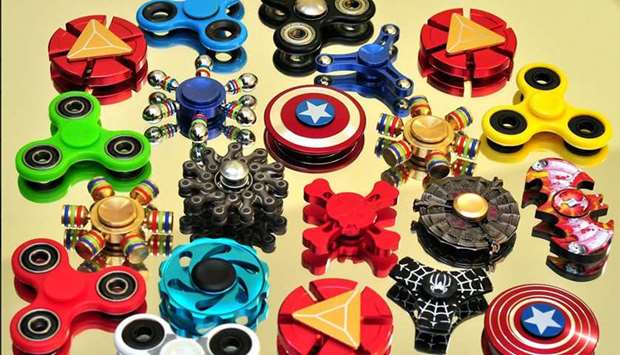A fidget spinner is made of either plastic or metal and has a ball bearing in the middle, allowing the toy to spin when held between the thumb and middle finger. Aside from the ball bearing, a typical fidget spinner usually contains two or more weights (or additional ball bearings) on the sides although the design and material may vary.
According to merchandisers in Qatar, fidget spinners hit the market in the first quarter of the year. Their popularity peaked soon after mainly among younger children, pre-teens and even with some adults.
Since the toy made its Qatar debut, different types of fidget spinners are sold in the local market and the prices range from as high as QR165 to as low as QR5 depending on the material, design and the store selling the product.
Some of the popular but expensive fidget spinners such as those made of die-cast metal or those with special or novelty designs are now selling at slightly lower prices in toy shops and hypermarkets, it is found.
A merchandiser at a major hypermarket in Doha attests to the popularity of the toy, saying: “When we started selling fidget spinners, we initially displayed around 1,000 pieces on our shelves and half of the stock was sold in just a few days.
“But at the same time, we also suffered losses of about 50% of the initial display because the fidget spinners were exposed and customers can easily take them out of the packaging. Today, we place them inside a plastic box with an RFID (radio-frequency identification) tag.”
Initially, the fidget spinner was marketed as a stress reliever and a tool to help people with attention deficit hyperactivity disorder, anxiety and autism. But it has become so popular over time that many people have posted DIY (do it yourself) videos online on “how to make your own fidget spinner”.
However, despite its popularity, many consumer watchdog groups were quick to tag fidget spinners as having “health or choking hazards”. Because the toys are produced by different manufacturers abroad, some organisations also claimed that fidget spinners contain “deadly amounts” of lead.
One video posted on a popular social media site showed a group of people (presumably the parents of a child) struggling to saw off the ball bearing that the child inserted on his finger. Another video showed a young man whose fingers and palm sustained deep cuts from a DIY fidget spinner made out of metal blades.
Many public and private schools in Qatar have reportedly banned or imposed sanctions on students caught playing with fidget spinners inside the campus.
Don John A Vallesteros, moderator of The Link, the official school publication of the Philippine School Doha, told Gulf Times that as a general policy any toy or electronic gadget is prohibited inside the campus.
“These items, including fidget spinners, are distractions, especially during class hours. Hence, the school prohibits them. In case a toy or similar item is confiscated, the school immediately informs the student’s parents. Also, the confiscated item will be returned at the end of the school year,” he said.

Fidget spinners continue to be a popular toy among children and even some adults.
Fidget spinners have been regarded as among the “must have toys of 2017” but many people, including some experts, remain divided over whether they are beneficial or harmful, especially to children.

